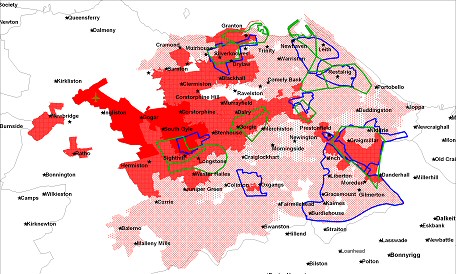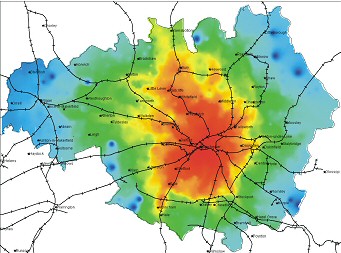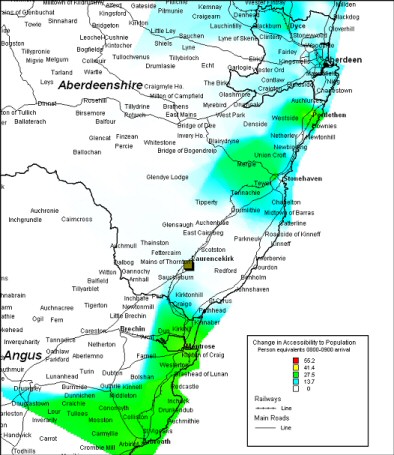Accessibility Planning
The Prime Minister started his forward to the July 2004 “Future of Transport White Paper” by noting that “transport provides access to jobs, services and schools, gets goods to the shops and allows us to make the most of our free time”. There is nothing unusual in top-level statements about improving accessibility, but rather than accessibility improvements being expressed as broad unmeasurable aspirations the accessibility planning process defines a framework to clarify accessibility goals and manage progress with delivery.

Public Transport Travel Time, Areas of High Unemployment and Social Inclusion Partnership Areas in Edinburgh.
Accessibility planning is not a new concept, but the Government’s Social Exclusion Unit (SEU) in their 2003 report “Making the Connections” identified that to manage progress on cross sectoral action, there needed to be clear accountability for the quality of accessibility experienced by all sections of the population, and defined procedures to support delivery of improvements. This is both a major challenge and opportunity for the transport sector.
Accessibility planning is therefore now at the centre of transport delivery and between May 2003 and April 2004, DHC and the University of Westminster led a large project for the Department for Transport (DfT) to develop practical procedures and pilot then across England. The results of this work provided a major input to the national guidance published in August 2004. In parallel with this DHC has also supported the Scottish Executive in defining and promoting accessibility planning approaches for Scotland through the new Scottish transport Appraisal Guidance (STAG).
All local authorities in England outside London are being required to prepare accessibility strategies as part of their 2005 Local Transport Plans, with detailed accessibility plans to follow in 2006. The DfT guidance sets out policies, procedures, and issues to be considered, but in simple terms it involves:
- Identifying through clear and consistent evidence from qualitative and quantitative sources where there are gaps in service provision for access to work, health, learning, shopping, and leisure, particularly for those people who are most in need.
- Knowing who benefits from accessibility changes resulting from transport, land use, and other service delivery changes i.e. does the local transport strategy provide the greatest benefits for rich or poor, rural or urban, old or young.
- Multi-sectoral delivery of joint action plans targeting accessibility issues including integrating socially necessary transport service provision, and improving improved information on transport options.
When there is a need for cross sector funding and delivery to tackle accessibility problems then accessibility planning can be expected to become increasingly recognised as the main process for sourcing relevant evidence, building appropriate partnerships and planning practical improvements jointly with all necessary stakeholders.
Accessibility Modelling

Our modelling approach can cope with very large models such as a full 10000 zone matrix undertaken for the Greater Manchester area, shown here.
Modelling of accessibility is expected to be a significant aspect of the Accessibility Planning process, both in understanding strategic issues and developing locally-relevant solutions. DHC have used advanced modelling techniques to understand access employment, education, healthcare and social opportunities.
DHC’s “ACCALC” approach has been progressively developed over the last five years from the initial version sponsored by the Scottish Executive in 1999, which was designed primarily for use in small development planning applications. These tools were further developed to meet the needs of a number of local authority clients and the DfT piloting project introduced several fresh challenges. New features are continually being added to ensure that ACCALC continues to offer leading edge solutions to modelling and a higher degree of functionality than the more basic approaches being delivered through more automated proprietary software packages.
By working in partnership with Automatica Ltd, DHC has now run models with over 10,000 zones and which have automatic import facilities from public transport databases. These modelling methods are therefore now proven in work for both DfT and Scottish Executive and can be set up for use in-house within local authorities. Our philosophy centres on central storage of data and then access by a wide range of users simply using their desktop web browser to adjust parameters such as time of day or number of interchanges, and generate their own analyses.

Change in Accessibility to population centres from Laurencekirk in Aberdeenshire after reopening of rail station, arrival between 0800-0900.
Our approach to accessibility modelling avoids the “black-box” syndrome of complex tools in which the user potentially has a poor understanding of the data manipulations or calculations being carried out. We prefer a transparent modular approach where each stage can be completed and fully understood, increasing ownership of findings by a range of users.
Using public transport data to reliably calculate journey times relies on routing algorithms that closely mimic the behaviour of travellers. This is vital if results are to be sensible to local stakeholders. Our system has been developed to be practical and realistic and for example is intelligent enough to search for the most appropriate bus stop at which to start or end a journey and not necessarily the one that is closest to the origin or destination.
A key aspect of undertaking modelling of this type that is often overlooked is the importance of using good quality data; on transport services, the demographics of the people groups being considered and the opportunities that are available. DHC has real-world experience of managing and manipulating these large and complex data sets, overcoming some of the deficiencies that can exist, and assisting the DfT develop guidance on their appropriate use. Our expertise has meant that we have also developed modelling parameters from national travel surveys and considered the effects of cost and reliability on accessibility (in addition to the conventional journey time).